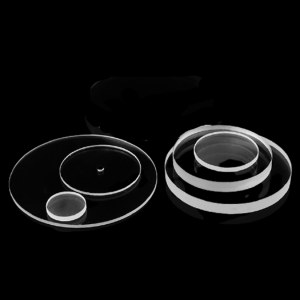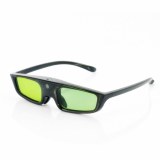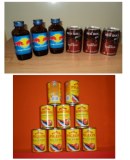Quartz Window
Price : 30--45 dollars
This non-crystalline, uv fused silica glass combines a very low thermal expansion coefficient with good optical qualities and excellent transmittance in the ultraviolet region. Transmission and homogeneity exceed those of crystalline quartz without the problems of orientation and temperature instability inherent in the crystalline form. It will not fluoresce under UV light and is resistant to radiation. Our fused quartz windows are made from high-purity quartz, which offers superior optical transmission properties, as well as exceptional thermal and mechanical performance.
Specification of Quartz Window
|
Material |
Fused Silica |
|
Diameter |
1 to 500 mm |
|
Diameter Tolerance |
+0/-0.02 mm |
|
Thickness Tolerance |
±0.01 mm |
|
Surface Quality |
10-5 |
|
Surface Figure |
λ/10 |
|
Parallelism |
1 Minute |
|
Coating |
Uncoated, AR, HR, Beamsplitter, etc. |
Our quartz glass windows are available in a variety of shapes and sizes, including standard sizes and custom designs to suit your specific needs. We also offer various coatings and treatments to enhance the performance of our quartz windows, including anti-reflection coatings, hydrophobic coatings, and more.
At TC Optik, we are committed to providing exceptional customer service and support, with fast turnaround times and competitive pricing to meet your needs. Contact us today to learn more about our optical window glass and how they can help you achieve your optical and industrial needs.
Types of optical window glass for your needs:
BK7 optical windows
Custom sapphire windows
ZnSe laser lens
Germanium window
Silicon window
Borosilicate glass windows
Float glass optical windows
What's the difference between quartz windows and fused silica glass
Quartz windows and fused quartz glass are both materials that are commonly used for optical windows and other high-performance applications. While they may appear similar, there are some key differences between these materials.
1. Composition:
Quartz windows are made from natural quartz crystals that are mined from the earth, while fused silica glass is produced by melting high-purity silica using high-temperature techniques.
2. Purity:
Fused silica glass is typically purer than quartz, with a purity level of over 99.9%.
3. Transmission:
Both materials have excellent optical transmission properties, but quartz typically has a lower transmission range in the ultraviolet spectral region than fused silica glass.
4. Refractive Index:
Quartz has a slightly higher refractive index than fused silica glass.
5. Thermal Expansion:
Quartz has a higher coefficient of thermal expansion compared to fused silica glass, making it more prone to thermal shock.
6. Cost:
Quartz is typically less expensive than fused silica glass.
Quartz windows are commonly used in applications that require a lower level of purity and precision, while fused silica glass is often used in applications that require higher levels of purity, precision, and performance, like in high-end optical components, cutting-edge semiconductor OEM applications, and high-intensity discharge lamps. Ultimately, the choice of material depends on the specific application and the performance requirements of the project.
Fused silica glass properties
Fused silica glass is a high-purity form of silica that is produced by melting high-purity silica at very high temperatures and then rapidly cooling it to form a glass. Some key properties of fused silica glass include:
1. High purity: Fused silica glass is one of the purest forms of silica, with a purity level of over 99.9%.
2. High temperature resistance: Fused silica glass can withstand temperatures up to 1200°C without softening or undergoing deformation.
3. Low coefficient of thermal expansion: Fused silica glass has a very low coefficient of thermal expansion, making it highly resistant to thermal stress.
4. High transmission: Fused silica glass has a very high transmission range, allowing for excellent optical performance across a broad range of wavelengths.
5. Hardness: Fused silica glass is very hard and resistant to scratching, making it ideal for use in harsh environments.
6. Low thermal conductivity: Fused silica glass has a low thermal conductivity, which makes it an excellent insulator.
7. Chemical inertness: Fused silica glass is highly inert and resistant to chemical attack, making it ideal for use in chemical and high-ph applications.
These properties make fused silica glass an excellent material for use in optical applications, such as lenses, prisms, mirrors, and windows, as well as in high-temperature applications, semiconductor-quality quartzware and other high-performance applications.
Fused silica glass uses
Fused silica glass has a wide range of uses in various industries and applications, including:
1. Optical components: Fused silica glass is used to make high-end optical components such as lenses, prisms, mirrors, and windows. It has excellent transmission properties in the ultraviolet, visible, and infrared regions of the spectrum, which makes it ideal for use in a broad range of optical applications.
2. Semiconductor processing: Fused silica glass is commonly used in the semiconductor industry to manufacture wafer carriers, supply tubes, and other components that require high-purity and resistance to high temperatures and chemicals.
3. Aerospace: Fused silica glass is used to make windows and lenses for aerospace applications, as it can withstand high temperatures, high radiation levels, and environmental stresses.
4. High-temperature applications: Fused silica glass is used in high-temperature applications like furnace observation windows, reflectors, and insulators due to its high thermal stability and resistance to thermal shock.
5. Metrology: Fused silica glass is used in precision metrology and measurement systems, such as interferometers and optical profilometers.
6. Military: Fused silica glass is used as a structural material in military applications due to its high mechanical strength and durability.
7. Medical: Fused silica glass is used in medical applications, such as microfluidic devices and lab-on-a-chip systems, for its chemical inertness and biocompatibility with biological fluids.
The unique properties of fused silica glass make it an ideal material for a broad range of high-performance applications across many industries.
IR vs. UV Grade Fused Silica
UV and IR grade fused silica are two different types of fused silica glass that are optimized for use in different wavelength ranges of light.
UV grade fused silica has high transmission properties in the ultraviolet range of the spectrum, typically between 180 to 400 nanometers (nm). UV grade fused silica has a low level of impurities, which makes it ideal for use in applications such as UV spectroscopy, imaging, and laser optics.
IR grade fused silica, on the other hand, has high transmission properties in the infrared range of the spectrum, typically between 1.5 to 6 microns. IR grade fused silica is optimized to have low absorption in the infrared region, which makes it ideal for use in applications like Fourier transform infrared (FTIR) spectroscopy, IR imaging, and high-temperature IR optics.
While both UV and IR grade fused silica have excellent thermal properties, high mechanical strength, and low thermal expansion coefficients, their optical properties are optimized for different ranges of the spectrum. Therefore, it is important to choose the appropriate grade of fused silica based on the specific application and wavelength range requirements.
If you want to buy fused silica lens, please leave us a message.
Contact : wei Fande, 0086 374 2088716
Good deal: buying from seller
We invite you to read our terms of use. You can also visit our FAQ section and see our information section on the risks associated with counterfeiting.
|
This page is about importers and exporters of Quartz Window Search in a category : Everything else / Bulk Search in a category : window, quartz |
Friday, October 17, 2014
Quantity : MOQ: 10 - Price : USD 13 - USD 19
3D Glasses with Active Shutter have been exclusively designed to work with 3D Projections to provide the wearer a real feel of 3D entertainment. Love 3D? Then you will love these active shutter 3D glasses that have been designed to work with 3D DLP projectors. The reason for these...
Pong Yuen Holdings Limited
- pongyuen
- 000000 - Hong Kong
- +85 2 23 65 88 10
- (86)15018920105
Thursday, June 10, 2010
SIAM-SUWAN-INTERNATIONAL-COMPANY-LTD is a French-Thai company established in Songkhla in the South of Thailand. It markets products directly from the big Thai suppliers, without intermediaries, and which offers you also services in French. Not gaseous RED-BULL in bottles glass of...
SIAM-SUWAN-INTERNATIONAL
- siam-suwan
- 90140 - SONGKHLA
- +33 6 14 48 52 24
Sunday, April 26, 2015
IDP INTERIER Design Work, For all interier painting, Table, Rack, Chair Design Contact IDP interier Thanks & regards Ibrahim sha.S IDP INTERIORS 9244449444 Location : NAMAKKAL, 637001 namakkal, Contact : Anbu Palani, 09244449444
vibba
- 637001 - namakkal
- 09244449444










